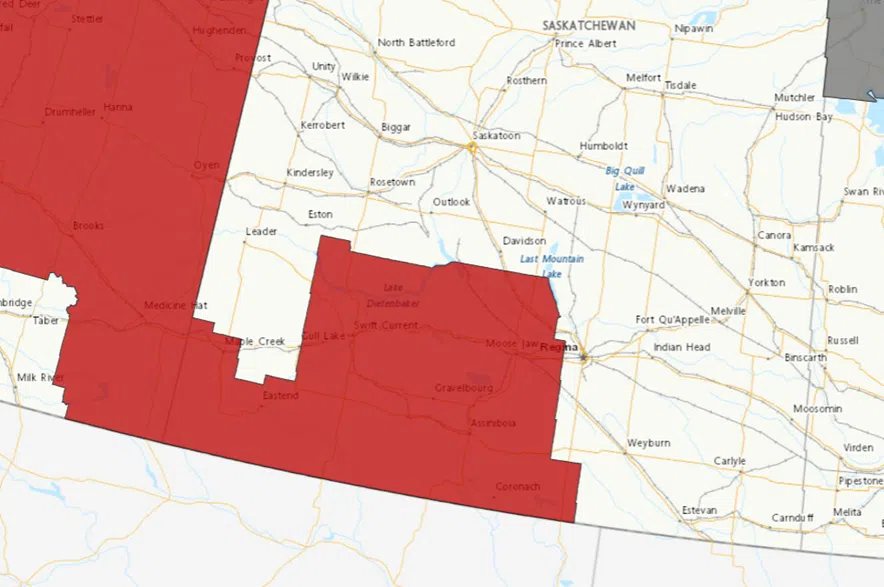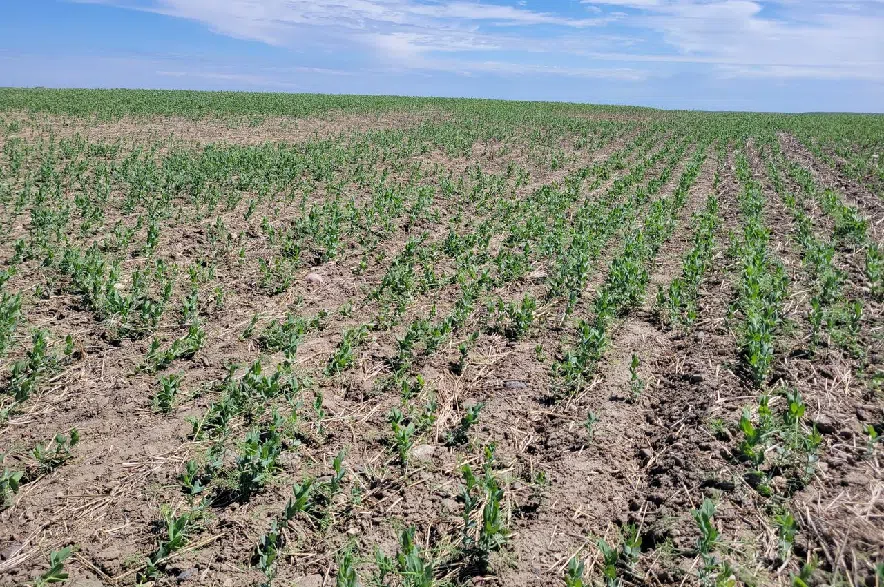It might be time to crank up the air conditioning in your house and your car.
Environment Canada has issued heat warnings for southwest Saskatchewan, with temperatures in the area expected to reach 32 C over the next two days, combined with overnight lows near 16 C.
Read More:
- Drought support for farmers coming from provincial, federal governments
- Eight tornadoes confirmed to have touched down during June 19 ‘outbreak’
- C-5 protesters pick up tickets after allegedly blocking bridge north of Prince Albert
Swift Current, Moose Jaw, Assiniboia, Coronach, Eastend, Maple Creek and areas as far south as the U.S. border were all included in the warning. Producers in the southwest have already been struggling with dry conditions this season, prompting additional help from the provincial and federal governments.
Eric Dykes, a meteorologist with Environment Canada, said several other parts of the province, including Regina, are coming close to meeting the threshold for a heat warning.

Swift Current, Moose Jaw, Assiniboia, Coronach, Eastend and Maple Creek were all included in the heat warning on Wednesday. (Environment Canada)
“If it gets a couple degrees warmer than expected for today, then you might see that heat warning pushed ever so closer to Regina and perhaps areas just around the Swift Current, and Moose Jaw areas,” Dykes said.
Lloydminster is also under a heat warning, as daytime high temperatures are expected to get up to 30 C, combined with overnight lows near 14 C. Dykes said the Battlefords, Meadow Lake and Prince Albert are also getting close to reaching the threshold for a heat warning.
Environment Canada uses a different threshold for heat warnings in those areas. For a warning to be issued, temperatures would need to reach a high of 29 C for two days in a row, combined with an overnight low of at least 16 C.
“They will be monitoring the temperatures, and if they feel as though some of those temperatures will be a little bit warmer than forecast, they’ll certainly want to expand the heat warnings as necessary throughout the day,” Dykes said.
With hot weather in the forecast, the meteorologist said it’s important to wear hats, sunglasses and sunscreen, and to limit your time outside. He said it’s also important to check on seniors and not leave kids or pets out in a vehicle.
“This is very hot weather, and it gets very hot in the cars with the sun beating down on it as well,” Dykes said. “If it’s too hot for you, it’s definitely going to be too hot for infants and also for your pets.”
Dykes said the heat warning is not going to stick around for too long.
“We’re not looking at a long period of a heat wave of several days or a week. This will all pass with a cold front that comes through on Thursday night,” said Dykes.
“We’ll see temperatures drop a few degrees on Thursday across the entirety of southern Saskatchewan, and then fall even further with some rain come the weekend.”
On top of the hot weather, Dykes said severe storms could roll through the western parts of the province, close to the Alberta border, on Wednesday evening. He said the storms may move towards Saskatoon and Regina, losing strength as they move east.
Dykes said both Saskatoon and Regina could get strong winds and hail as large as quarters, though no tornadoes are expected to form during the severe storms in the forecast.
The latest updates on the heat warnings can be found on Environment Canada’s website.
Risks of overheating
While the warmer temperatures could mean more pool days and patios in your future, it’s also important to take care not to overheat.
Dr. Carla Holinaty explained the spectrum of heat-related illnesses, ranging from mild to serious.
On the milder end is heat exhaustion, when people feel sick after spending too much time in the heat.
“We tend to see things like headaches, nausea, dizziness, weakness. Maybe people are feeling really thirsty, they’re quite sweaty, and their body temperature starts to go up,” Holinaty explained.
While you might develop a fever, Holinaty said the brain is unaffected by heat exhaustion. That changes with heat stroke, though, when overexposure to heat means a person’s body can’t keep up anymore.
“You see those mental effects, so they’re confused, they’re unco-ordinated, they’re dizzy or they’re fainting, or they might even be unconscious. And this is a medical emergency,” Holinaty said.
Holinaty said to call 911 when heat stroke occurs, because it compromises the brain and other internal organs.
To avoid symptoms progressing from mild to severe, Holinaty recommended drinking lots of water and moving to somewhere cooler while continuing to monitor your body.
Some people are also more at risk of overheating, including older adults and children.
Holinaty said if your kid is getting too hot, they might develop a heat rash or a headache.
“Maybe they’re getting some muscle cramps in their arms or their legs and their belly, and they’re feeling like their muscles are sore. They’re really seeming more thirsty. They’re looking really hot and flushed,” she said.
In those cases, Holinaty says they’ve been in the heat too long and need to cool off quickly.
Pack on that SPF
Hot and sunny days can also lead to sunburns.
Even with all the sunscreen options available, Holinaty said she still gets patients coming in with severe sunburns.
“Sometimes we’ll see people that have, you know, those big blisters, or they’re really sloughing off big chunks of the skin once those blisters have healed,” she said.
Not only are sunburns painful, but Holinaty said they can also put people at risk of other skin complications, including cancer.
Prevention is the best medicine for sunburns, but when they happen Holinaty recommended cooling the skin with cold showers or ice packs.
If you’ve developed big blisters or are unsure of whether you should seek medical treatment, Holinaty said to call your family doctor.
–with files from 980 CJME’s Marija Robinson











